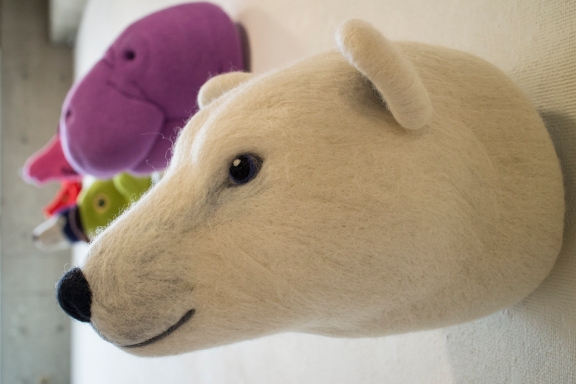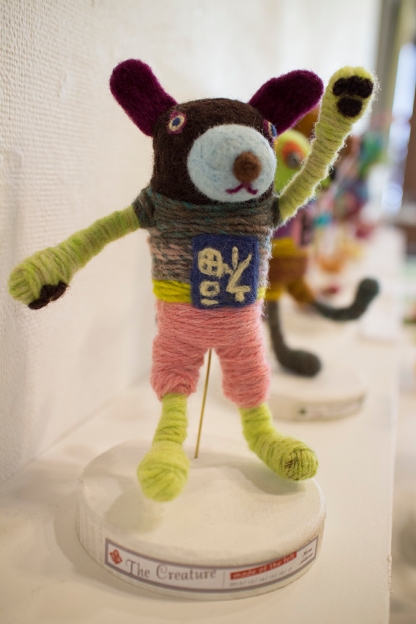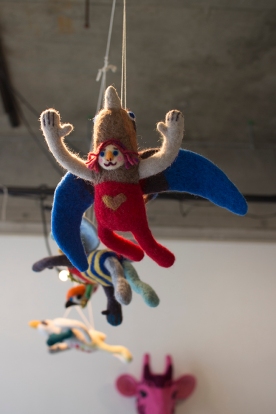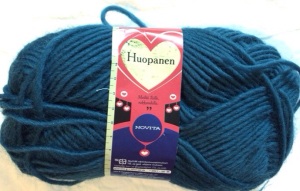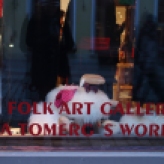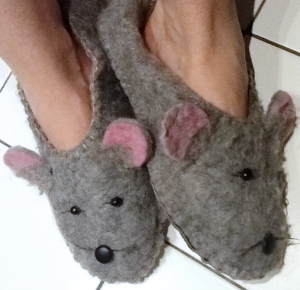 Yuko and Harunobu Aihara felt together. The pair recently had a fiber sculpture exhibition called Ikimono Expo 2 at Gallery Choukou (ギャラリー澄光) near Okusawa station (on the Meguro line) that shows how creative and detailed needle felting can be. The couple started 7 years ago with a small needle felting kit but immediately saw potential for their own designs and started with their own creations almost immediately. One thing that I noticed was the variety of color in the work and I know that they base structure takes a lot of wool. They admit to having a lot of wool roving–two large plastic boxes in fact. For two artists working together and using the same medium, their aesthetic is completely different. And all of the incredible detail (except for Harunobu Aihara’s yarn wrapping), is done with felting needles, not embroidery.
Yuko and Harunobu Aihara felt together. The pair recently had a fiber sculpture exhibition called Ikimono Expo 2 at Gallery Choukou (ギャラリー澄光) near Okusawa station (on the Meguro line) that shows how creative and detailed needle felting can be. The couple started 7 years ago with a small needle felting kit but immediately saw potential for their own designs and started with their own creations almost immediately. One thing that I noticed was the variety of color in the work and I know that they base structure takes a lot of wool. They admit to having a lot of wool roving–two large plastic boxes in fact. For two artists working together and using the same medium, their aesthetic is completely different. And all of the incredible detail (except for Harunobu Aihara’s yarn wrapping), is done with felting needles, not embroidery.
Aihara Yuko uses the artist name Nicosui. Real animals and the animal characters of Grimm’s fairytales inspire her work. She chooses her subjects by how much they intrigue her. Sometimes it is the story, as with the fairytale creatures, but often it is the animal’s face and her desire to try and create a particular shape or feature. She chose the koala because she was interested in recreating the fluffy ears and the shape of the muzzle. She told the most difficult was the giraffe because of the structure. It was surprisingly longer and thinner in the nose than compared to skull.
 While Nicosui’s creations look realistic, she seldom chooses the animal’s natural color. Instead she chooses a color palette that represents what she sees the spirit of the animal: red for the lion, and pink and purple for the feminine nature of the giraffe, green for the koala. She also makes more realistically colored animals in small scale for broaches.
While Nicosui’s creations look realistic, she seldom chooses the animal’s natural color. Instead she chooses a color palette that represents what she sees the spirit of the animal: red for the lion, and pink and purple for the feminine nature of the giraffe, green for the koala. She also makes more realistically colored animals in small scale for broaches.
What Nicosui wants people to know about her work:
ぜつめつ動物をなくす (prevent extinction of animals)
Many of the characters she creates are endangered animals. She hopes to inspire the viewer to live in peace with animals and take care of the earth so that people and animals have a healthy place to live.
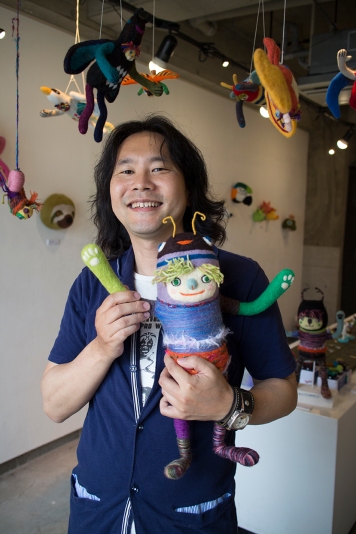
Harunobu Aihara is an illustrator and graphic designer. He is also a bassist in a 70’s music hard rock band. Nicosui’s work has more realism while Aihara’s work is about unique, fantastical characters. His style is whimsical and humorous. He says his style has almost always been like this. This year was the first he tried making insect-inspired creature. He really enjoyed them so he made a lot.
It’s not just Aihara’s aesthetic that is different from Nicosui’s. His work process is also completely different. He says that Nicosui takes a lot of time with each project working slowly to perfect her details while he prefers いきよいでつくる, making with momentum.
While he often starts with a sketch, which he may or may not adhere to. Sometimes he freestyles with wool. The base of his sculptures are wire armatures. He builds dimension over the armature by wrapping wool roving around it, and using felting needles to refine the shape. The color detail is a layer of needle felting, sometimes wrapping with yarn or fabrics depending on the effect he wants
He also made many angels, which also have insect or avian features. He said that they are slightly disguised to look like a bird if a person looked up to see one flying in the sky.
His goal: たのしと平和. He wants to bring viewers moments of enjoyment where they can feel peace through happiness.





